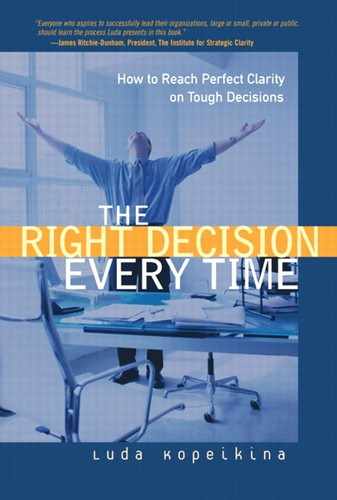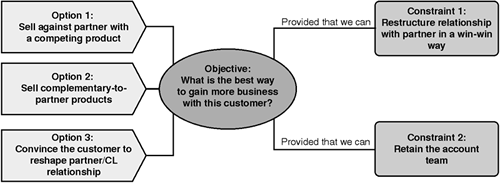
Mastery comes most readily to those who look with the eyes of a beginner, and it comes with great difficulty to those who assume they already know. | ||
| --Nicholas Lore[1] | ||
By its nature, any decision perspective is limiting. It puts a decision into a frame, highlighting certain elements and hiding the rest. A wrong decision perspective presents a major difficulty in arriving at a clear choice. Effective executives are “frame busters” and “frame artists.” They know that decision frames are partly controlled by the formulation of the problem and partly by the norms, habits, and characteristics of the decision maker[2]. They also know that we rarely spontaneously question the formulation of a problem or the underlying personal or business assumptions behind our current perspective. We rarely reframe instinctively.
Key Point
In order to reach clarity on a decision faster and easier, learn to be a frame artist—be able to quickly reframe.
In the following example, Brian is dealing with a frame imposed by historical business patterns.
What happened?
All the officers of the company had prior history with the current vendor and believed that the current vendor had never changed its pricing in negotiations, especially not while under pressure. They were operating under an assumption: “Current vendor does not negotiate.”
What did Brian know that other officers did not know? He had learned that the CEO of the current vendor would be retiring soon. Brian concluded that the CEO probably did not want to lose a major customer and a major contract before his retirement. It happened that the Vice Chairman paid attention to the same piece of information as Brian did and had the same perspective as Brian.
In the current environment, the stated assumption about the current vendor was wrong. But the rest of the executives were framed by the presence of this perceived constraint in the problem definition. If Brian and his Vice Chairman did not reframe, the company would have overpaid $10 million for the contract.
You have already worked with identifying assumptions behind your decision in the process of clarifying constraints. The techniques in the next chapter will help you identify assumptions and other constraints that are false.
Frames come from two main sources. First, frames come from the way the problem is presented to you. It might be tinted with other parties' opinions, media expectations, and other environmental factors. Second, frames come from unrecognized personal and business assumptions, attitudes, and habits. Whatever the source, you should always be on the lookout for framing factors.
| --Friedrich Nietzsche[3] | ||
The value of identifying the appropriate frame is enormous. Finding the appropriate decision perspective can point to the right solution, identify additional options, and help you identify a problem area or block in relation to the decision.
Finding the appropriate frame of reference can point to the most appropriate option—making the decision clear in an instant, as you can see from the following example.
During the exercise, Stuart realized that the most important aspect of the situation was the eventual consistent delivery of quality product in the two plants. The current plan could not guarantee it. His decision was contrary to the expectations of the various parties involved, risky and gutsy: “Stop construction until we have a clear plan to deliver quality products.”
The story ends well—both plants started production on time, and “quality is so far, so good.” Under Stuart's leadership, the engineering team took some of the state-of-the-art, untested functionality from the design of the manufacturing line, enabling the vendor and the manufacturing group to deliver the project on time.
One major implication of operating in a “frame” is a difficulty in seeing other solution options or other ways of resolving the situation that may be open at the time[2]. A “frame” blinds you to other choices. Consider the following example.
What happened?
Jane found a different perspective—a shift from looking up to the partner because of its size to being equal to or even stronger than the partner from the perspective of additional product features valued by the customer.
Essentially, you can say that she is selecting a combination of Option 2 and Option 3, both of which were available to her before. But this new perspective allows her to add strength and power to Options 2 and 3 that were missing before. These options were “losers” if she approached them from the prior perspective—she did not know how to execute them. This new perspective allowed her to mentally take control. She immediately came up with a new option and an execution plan—a set of differentiated products to lead with that will allow her to accomplish Options 2 and 3.
A new perspective illuminates a decision in a new light. In many cases, this new perspective enables us to clearly see the problem that was blocking us from making a decision. The path of action becomes clear. Consider the following example.
What happened?
Steven's perspective shifted during the exercise, from blaming the sales force for not being effective in closing deals to realizing that the market shifted and that the sales team is continuing to sell with old tools. With a shift in perspective, a new problem area surfaced—senior management's responsibility for the current situation. An action plan became clear—“We need to work with the sales force and give them tools to win in the new environment.”
I believe that arriving at solutions to difficult problems often requires one or both of the following: seeing the problem from a new perspective and making novel connections between two or more ideas. | ||
| --Robin Hogarth[4] | ||
Perspectives are similar to views of a document through a magnifying glass. Certain parts of the writing are visible; the rest is hidden from view. You move the magnifying glass, and it amplifies other aspects of the document.
Similarly, a fresh perspective can bring into view certain parts of the decision that were previously hidden, allowing you to see the right solution.
One of the most important skills in decision-making is to recognize when an issue requires a fresh perspective (needs to be reframed). Experienced decision makers warn that if you continually use an inappropriate frame—in other words, if you continue to simplify in ways that blind you to what is most significant about the problem—you will eventually cast yourself and your organization into deep problems[5]. The issue is that it is extremely difficult to recognize this moment, as the following example demonstrates.
Is Karen “framed?” Detailed issues are being discussed, yet it is unclear whether the company can be brought to a state that will enable Karen to financially gain at the level she initially intended. In fact, financial projections confirm that it will be incredibly difficult to reach that point. So, should the question be framed differently? “Knowing everything that I know about this business after five years, can this business deliver the financial return that I am looking for? If not, is this the time to consider exiting?”
If you ask Karen, she will deny that she is framed, as did all decision makers who were “framed” before the exercise and were actually able to reframe during the exercise. From the outsider's perspective, it may appear that Karen was framed. However, she was convinced that accepting the money even under bad conditions was the right path for her. She decided to proceed and is in the process of testing the new business model. The model seems to be working! Karen might have been right after all.
Good Practice for a Frame Artist
Before resolving a difficult issue, even if you believe that you are not framed, make it a practice to identify alternative frames and shift your perspective—ensuring that you are making the decision from the right perspective. You often reach clarity by shifting your view of the problem until you find the one that clicks.
To be fair, decision makers realize that finding alternative perspectives is not easy. Many have devised their own methods of doing so.
One CEO gets involved in other people's decisions by sitting on boards of nonprofit organizations, where he gets a perspective of a completely different environment, which consists of greater struggles for money and more soul-touching and difficult problems, much different from his own. Even though this involvement does not necessarily help him in making his decisions, it provides a different view of his issues that, in his words, “has proven useful a number of times.”
In order to reach clarity faster and more easily, learn to be a frame artist. Always assume that you are framed. Be able to generate alternative frames and shift your decision perspective a number of times until you find the right way to look at the decision.
| --Francis Bacon[6] | ||
Each time you are facing a tough choice, go through the following process that summarizes techniques discussed in detail in the next chapter. It should not take you more than 15 minutes when you are used to it.
Be in the Clarity State.
Relax constraints.
Stretch assumptions.
Look for the crux of the issue.
Stand back; find a broader viewpoint.
Shift a loss into a gain.
See the decision successfully implemented.
Most importantly, assume the “it's a game” attitude and have fun!


